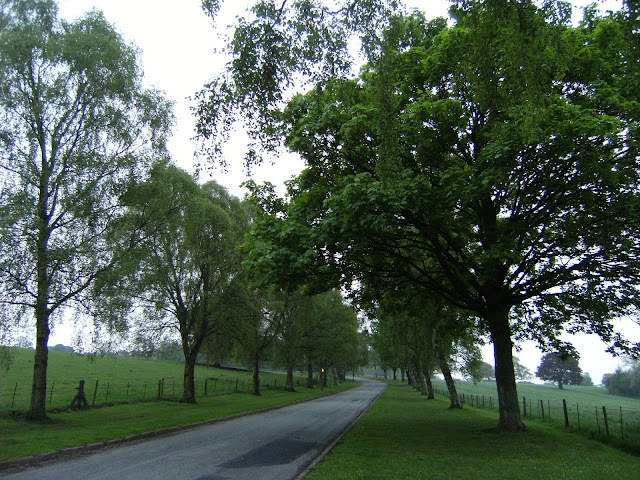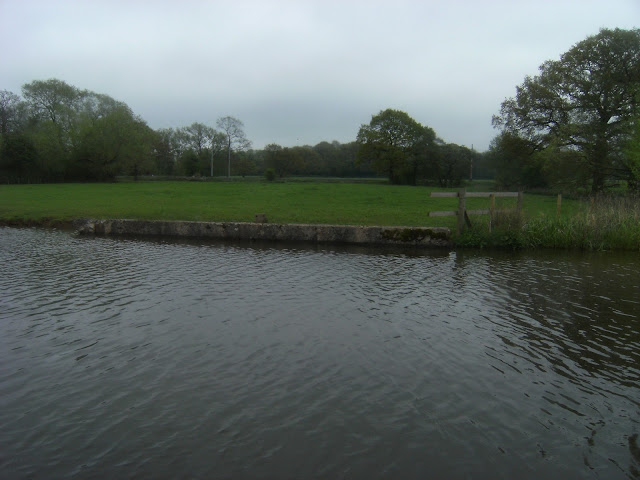We are moored just past Barlaston. and after tea last night we decided to go for a walk. We went over the railway line, past Wedgewood Station and up the hill To Barlaston Hall and Church. It was overcast with low cloud but still.
The avenue from the Wedgewood factory to the model village.
Church near Barlaston Hall.
Barlaston Hall.
The Hall was built in 1756 for Thomas Mills who was an attorney from nearby Leek in the Palladian style. It was designed by Sir Robert Taylor who was well known for the octagonal and diamond patterns in the sash windows. The Hall was surrounded by parkland. In 1930's the entire estate was bought by The Wedgewood Company as they had outgrown their factory in Etruria in Hanley. The house was made into the Factory college but when mining subsidence caused problems the college moved elsewhere. The building had a 4" crack through it. Wedgewood continued to maintain the building but thieves stole the roof lead and vandals wrecked the place. They applied to demolish it twice! In the end it was sold for £1 to SAVE Britain's Heritage in 1981. The sale stated that the refurbishment had to be completed in 5 years. The National Coal Board agreed to fund the creation of a concrete raft to remedy the subsidence. This was reneged later and grants were not so easy to come by but it was completed by 1992. The building was sold with no internal work carried out to the Hall family and they still live there. The view across the valley is fantastic and it will be a really great place to live. We walked back down the to the railway and canal. The gates to the Wedgewood station were locked so obviously not used anymore but must have been busy when the factory was in full sway.
Josiah Wedgewood I.
We decided to go to the Wedgewood Museum and factory tour as weer were there. We got there before 1030 and went straight on nthe factory tour. It was a quick dash round but it certainly made you realise why the products are so expensive. Almost everything is done by hand with the decorative ware needing several firings and paintings etc and the liberal use of 22 carat gold. We heard that the present factory moved here in the late 1930's early 40's and the Etruria Factory closed completely in 1951. Much of the production area was not being used and you may remember that the company went bust a few years ago. An American Investment company now owns the company along with Waterford Crystal, Johnson's pottery, Royal Albert, and Royal Doulton. It seems that the Company concentrated on high value items now and left the bulk ware to others. The Astbury Black style has a cup and saucer for £1050. In the Factory outlet shop there had a plate on sale for £150+. It was dishwasher proof though!
The museum was like the 'Tardis' and went on and on. The items were a fantastic range. The famous Jasper ware took years and thousands of experiments to perfect. He kept ahead of the competition coming up with new processes and designs and used his contacts to promote them in the best of society. In the end we were 61/2 on the site including a cup of tea and a scone. It was a day well spent and it was good to learn of the life of Josiah Wedgewood and his contemporaries. Josiah was born as the youngest of a 12 in a potters family. He contracted smallpox when he was young and this badly damaged a knee. This rendered him not suitable for being a hands on potter as it was physical work. He therefore ended up in the design and technology of pottery. He was able to better the process of making pottery and he joined in with a factory owner who also taught him the basics of management. He set up on his own and rented several potteries before designing and building his own in Hanley and called it Etruria. This was set up as a factory process. He was a patron of turnpike roads as he was fully aware as the delivery of his raw materials and finished products was not satisfactory via pack horse. He also was heavily involved in the promotion of the Trent and Mersey canal as he knew this would make him money in the long run and the Etruria factory was right alongside it. His knee was so damaged that he had it amputated and had a wooden leg. He became a Fellow of the Royal Society for his experimental and scientific developments. He remained involved with science and technology and kept Wedgewood designs at the fore front of fashion. He was a great man and died in 1795 with a fortune of £600,000 which would be worth £33 million today!! One of his grandson's turned out to be Charles Darwin too.
The view from our off side. You can just see the platform of the Wedgewood station platform. The railway is quite close but with welded rails and electric trains it is not too noisy at all.





No comments:
Post a Comment